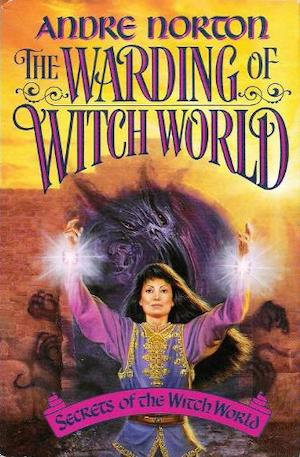Although I was encouraged to read several of the collaborations before venturing this epic roundup of all the Witch World threads and stories, I was stubborn and stuck to my schedule, and here I am. I see why it might have been useful to have read the Griffin collaborations at least, for the backstory on some of the characters and situations, but I didn’t have any particular trouble figuring out what was going on.
The Warding of Witch World is Norton’s longest novel by far. It seems to have been meant to be a tour de force, and for the most part I think it succeeded. Here for the first time I really felt how epic the scope of the Witch World is.
For me, Norton’s worlds have always seemed a little bit claustrophobic. Even when she’s roving the spaceways, her focus concentrates in her tiny, cramped, retro-classic rocket ships. Her planets are full of a wide, indeed wild variety of flora and fauna, and her gift for breakneck pacing has few equals. And yet everything seems to happen in small, enclosed spaces, narrow valleys, steep canyons, and endless subterranean expeditions.
Witch World is a wide world, and varied. There’s Estcarp and the Witches, there’s Escore, the Dales and High Hallack, Arvon and the Waste, the sea and its rovers. And then there are all the worldgates and the worlds they open to, most of them dystopian hellscapes, plus the magics that open the gates of time, building on the tremendous sense of age that underlies the world. Norton manages to make us feel that this world has existed for ages and ages, and been inhabited by multitudes of creatures, many of them possessed of powerful magic.
A defining characteristic of this world is that it is full of portals to other worlds, universes, whatever they may actually be. Most if not all of the peoples we meet in the series came from somewhere else. The Old Race, the people of the Witches, may be original to the world, but the rest came in through gates, usually fleeing some evil, either individual in the case of Simon Tregarth, or en masse like the Sulcarmen or the horrible Kolder or the Hounds of Alizon.
All the forces of the Light come together in this final volume of the saga. Their mission is to find any gate that may still, be active, and to shut it down against invasions from the Dark. There’s no mention of good people seeking refuge. It’s all about keeping out bad people.
This is not so much a single long novel as a trilogy of short novels with a framing device, a gathering of forces to send individual small parties to different regions of the world. Members of each expedition are chosen either by the Witches or by less easily defined powers. Each member has skills and powers that will turn out to be essential to the finding and closing of gates. Not all are obvious: there are apparently random persons or creatures met along the road, and each group has at least one young person who either has no known talent or who feels themself to be a failure in some way.
In the first group, which explores the south, Keris Tregarth, son of Kyllan Tregarth and the Lady of the Green Silences, has no magical powers at all, despite his doubly magical heritage. And yet this becomes his great strength, when he offers himself to the adept Hilarion. Hilarion will take over his body to destroy a gate and the evil that surrounds it. Keris’ lack of magic makes this possible—there’s nothing to interfere with the adept’s powers—and no one expects his soul or his personality to survive.
Keris is a brave young person. He’s very much aware of his responsibilities as a Tregarth. His family are famous defenders of Estcarp and Escore, and he makes the choice to do his ancestral duty.
Also in this company is a hereditary enemy of the Light, Liara, whose brother is a lord of the Hounds of Alizon. She is thrust through a gate into Lormt and conscripted into the mission, but she turns out to be invaluable to it. Although her people loathe magic, her family has magical ancestry, and she has inherited her ancestor’s powers. A good part of her mission is to learn to accept those powers, and to use them to defend the world.
The second adventure turns to High Hallack and the Dales and the Waste beyond, and stars the house of the Gryphon. Kerovan and Joisan hold fast in their fortress, but their son Firdun joins the expedition to the gates. Firdun has a shameful past. He’s redeemed himself and become a powerful master of wards, but he’s never been able to meld psychically with the rest of his family.
This, like Keris’ lack of magic, turns out to be his strongest asset. He helps to ward his part of the world, to defeat an evil mage and destroy dark gates opened by blood sacrifice. He finds a magical love, and works together with another misfit son, the part-Were Kethan, along with characters from later collaborations: a small party of Kioga warriors and their horses, and a trio of Keplians and their human allies. As with Liara and her brother, the Keplians originate in the series as creatures of the Dark, but they’ve been redeemed and are now fighting for the Light.
Buy the Book


In the Watchful City
The final expedition forays into the far north to find the worst of all the gates, the one that seems to be the core of the problem. The famous-family connection there is the son of Koris of Gorm and his Lady Loyse, Simond, and his Tor-born love Trusla. Trusla was a misfit among her people, but like Keris and Firdun, she proves essential to the success of the mission.
Simond and Trusla ally themselves with a Sulcar captain and his crew, and with a shaman of the Latt and her warrior-protector and a strange monkeylike animal with healing powers. They’re soon joined by a Sulcar wavereader, a sea witch named Audha, who has been tortured by the Dark. Their journey takes them by sea and then through the heart of a glacier to the original gate through which the Sulcarmen came. This gate is jammed open by a strange ship, and its guardian is the Sulcars’ bitter enemy.
Whereas the other gates were controlled by straightforward manifestations of Big Bad, the creature who occupies this one is of neither the Dark nor the Light. Urseta Vat Yan is doing tremendous harm to the world, but she has strong reasons for doing it. The Sulcarmen have done her great harm, and now she is trapped between worlds, unable to go forward but also unable to go back.
This last mission is not only to close the gate forever, but to find a way to send Urseta Vat Yan back where she came from. Audha, like Keris before her, serves as a literal mouthpiece for the adept, with the same potential price.
It all works out in the end, as it has in the previous sections. There’s a short epilogue in place of the usual abrupt ending, with everybody gathering in Es, making speeches and being praised and feted for their accomplishment. Thanks to their epic efforts—and in some cases their ultimate sacrifice—the gates are all closed. Witch World is no longer open to anything that might happen to stumble into it. Whatever that happens after this will happen within the bounds of the world, and to the peoples who have made it their home.
The plotting repeats itself a fair bit. All the expeditions start off with horses and pack trains, for example, and run into high cliffs that require the same set of decisions about leaving the horses behind—though not, in their sections, the Renthans or the Keplians. I was faintly disappointed that there wasn’t any lengthy subterranean quest—it’s hardly a Norton book without one. But then, at the very end, the northern expedition forayed into the heart of a glacier. That was gratifying.
As a grand finale, I think it works. We get to visit all our favorite people and some of our favorite places, and they get to do what they do best, in the best cause of all: saving the world. We can imagine that there’s plenty more for them all to do, that their world will go on and their magic will continue, but without the constant threat of incursions from Outside. Their lives will go on and they’ll continue to learn and do and be.
I might go back later and check out a Witch World collaboration or two, but for now I’ll move on to No Night Without Stars.
Judith Tarr’s first novel, The Isle of Glass, appeared in 1985. Since then she’s written novels and shorter works of historical fiction and historical fantasy and epic fantasy and space opera and contemporary fantasy, many of which have been reborn as ebooks. She has written a primer for writers: Writing Horses: The Fine Art of Getting It Right. She has won the Crawford Award, and been a finalist for the World Fantasy Award and the Locus Award. She lives in Arizona with an assortment of cats, a blue-eyed dog, and a herd of Lipizzan horses.










